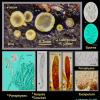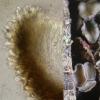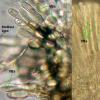
17-11-2025 21:46
Philippe PELLICIERBonjour,Récolté sur bois pourrissant de feuillu

20-11-2025 14:14
Mick PeerdemanFound on the leaves of 'Juglans regia' in the Neth

20-11-2025 13:07
Mick PeerdemanIn January i found these black markings on the dea

20-11-2025 12:38
Mick PeerdemanDear all,Last week i stumbled upon a leaf of ilex

19-11-2025 23:21
 carl van den broeck
carl van den broeck
Dear guestIn Waardamme, Belgium, I found dozens of

19-11-2025 20:51
 Andreas Millinger
Andreas Millinger
Good evening,found this species on a felled trunk

19-11-2025 13:04
 Bruno Coué
Bruno Coué
Bonjour,je sollicite votre avis pour la récote

16-11-2025 21:09
 Robin Isaksson
Robin Isaksson
Anyone recognize this acc. to pictures.? Found on

18-11-2025 13:59
Nogueira HéctorNovember 14, 2025 Brazuelo (León) SPAIN Hymenosc
Mollisia caespiticia ?
Roland Labbé,
01-03-2009 02:23
Encore besoin d'aide pour ce Disco jaune ochracé.
Merci de vos réponses.
Roland
Détails :
Date de récolte: 2009 / 02 / 24
Substrat : culture intérieure sur bûche en décomposition d'érable rouge
Sporée non obtenue
Asques à 8 spores bisériées, avec crochet à la base, avec appareil apical inamyloïde, 48-50 x 5 -6 µm
Paraphyses cylindriques, à 1 ou 2 septa au tiers inférieur, avec vacuoles hyalines allongées ?, 50 x 2-3 µm, dépassant à peine les asques
Spores étroitement ellipsoïdes, lisses, non septées ? ou à un septum médian très mince et hyalin difficile à préciser et rarement observé, hyalines, avec 2-3 guttules, 5-7 x 2-3 µm, 5,9 x 2,5 µm en moyenne (10 spores), Q = 2,36
Excipulum en textura globulosa
Hans-Otto Baral,
01-03-2009 10:12

Re:Disco jaune ochracé
The excipulum looks like in Mollisia. M. caespiticia would be one of the very few lignicolous species of Mollisia with inamyloid asci. To verify it would be valuable to see living paraphyses. Only the spores are alive on your oil immersion photos. If the living paraphyses contain a reftactive elongate vacuole (typical of every true Mollisia) then I would identify M. caespiticia. Perhaps a median section of the apothecia (especially marginal region) would be helpful too.
I have only somewhat atypical images from a Mongolian collection, but the species is not rare in Central Europe.
Zotto
I have only somewhat atypical images from a Mongolian collection, but the species is not rare in Central Europe.
Zotto
Roland Labbé,
03-03-2009 01:27
Re:Mollisia caespiticia
Hi Zotto !
I have changed the plate and added inamyloïde ascus and lived paraphyses (yong specimens).
I think there are elongated hyaline vacuoles in the paraphyses as you daid.
This question : what do you mean by the excipulum looks like in Mollisia or what is the structure of a true Mollisia ?
I hope it'is all right.
Roland
I have changed the plate and added inamyloïde ascus and lived paraphyses (yong specimens).
I think there are elongated hyaline vacuoles in the paraphyses as you daid.
This question : what do you mean by the excipulum looks like in Mollisia or what is the structure of a true Mollisia ?
I hope it'is all right.
Roland
Hans-Otto Baral,
03-03-2009 15:57

Re:Mollisia caespiticia ?
Hi Roland
I cannot see a difference in your image to what I remember, the paraphyses on the left are still dead, those on the right too minute to be sure. Could you extract them in higher resolution, please? . Here I have an image of the close Mollisia ligni showing the VBs in marginal hairs and paraphyses. Similar VBs exist in M. caespiticia and in all true Mollisias. Without these VBs I am somewhat unsure with my determination of the genus.
Zotto
I cannot see a difference in your image to what I remember, the paraphyses on the left are still dead, those on the right too minute to be sure. Could you extract them in higher resolution, please? . Here I have an image of the close Mollisia ligni showing the VBs in marginal hairs and paraphyses. Similar VBs exist in M. caespiticia and in all true Mollisias. Without these VBs I am somewhat unsure with my determination of the genus.
Zotto



